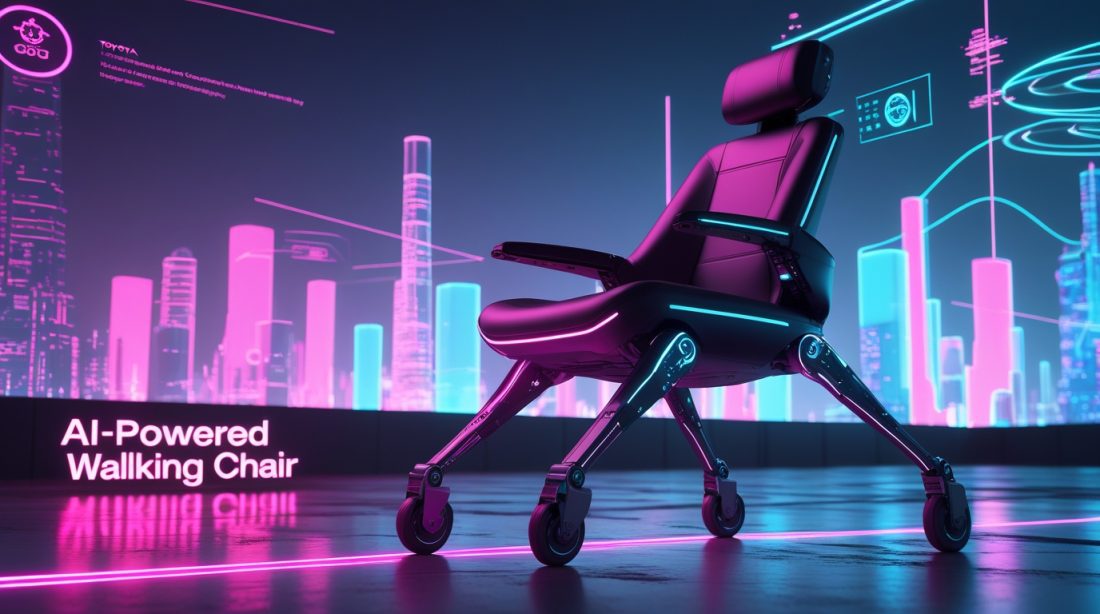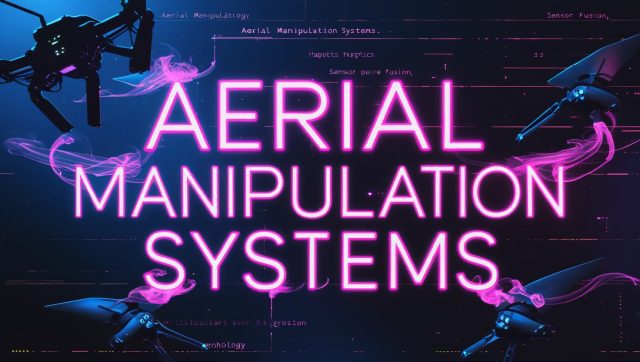In an industry often obsessed with speed, Toyota has made a strategic bet that the future of mobility may actually involve walking more slowly—and thoughtfully—than ever before.
Walk into any traditional mobility equipment showroom and you’ll find wheels—thousands of them. For centuries, wheeled devices have dominated personal mobility, from the simplest wheelchair to the most sophisticated electric scooter. Yet Toyota’s AI-powered walking chair, unveiled at the Japan Mobility Show 2025, challenges this fundamental paradigm by replacing wheels with four articulated legs inspired by nature’s most agile climbers.
The Walk Me isn’t merely another assistive device—it represents a strategic integration of biomimicry, industrial-grade artificial intelligence, and practical robotics that could redefine independence for people with mobility limitations. While still a prototype, this four-legged mobility aid demonstrates how industrial AI principles can transform specialized equipment into adaptive partners that navigate complex human environments.
Why Walk When You Can Roll? The Limitations of Traditional Mobility Aids
Conventional wheelchairs provide essential mobility but hit fundamental physical constraints. Stairs, uneven terrain, and tight spaces present near-insurmountable barriers, while vehicle transfers often require additional equipment or assistance.
The global population of adults over 65 is projected to reach 82 million by 2050, creating unprecedented demand for mobility solutions that preserve independence without compromising safety. Traditional wheelchairs, while improved through incremental innovations, remain constrained by their basic wheeled design—a limitation that becomes painfully apparent when encountering staircases or uneven surfaces.
Industrial AI approaches this problem not as a design challenge but as an integration problem: how to seamlessly connect human needs with environmental constraints through adaptive technology.
How the Walk Me Chair Mimics Nature’s Design
The Biomimicry Foundation
Toyota’s engineers turned to nature’s most versatile navigators—particularly crabs and mountain goats—when developing the Walk Me’s locomotion system. These animals share an exceptional ability to traverse unpredictable terrain with stability, using multiple independent limbs that adjust to surface variations in real-time.
The chair’s four articulated legs each contain sensors and actuators that operate independently, allowing the system to maintain stability even when navigating irregular surfaces like staircases. During ascent, the front legs test step height before pulling upward while the rear legs provide thrust and support—a coordinated sequence that mirrors how four-legged animals naturally climb .
AI-Driven Movement and Adaptation
What elevates Walk Me beyond a mere mechanical novelty is its integration of industrial AI systems that enable real-time environmental assessment and adaptation:
- LiDAR and radar sensors continuously scan the surroundings, creating detailed 3D maps of the environment
- Weight distribution sensors monitor the user’s position, automatically adjusting leg placement and seat tilt to maintain optimal balance
- Collision avoidance systems detect potential obstacles and automatically pause movement when necessary
This sensor fusion creates a continuous feedback loop where the chair adapts its movement strategy based on both the external environment and the user’s position—a hallmark of sophisticated industrial AI applications.
Table: Walk Me Capability Comparison
| Feature | Traditional Wheelchair | Toyota Walk Me |
|---|---|---|
| Stair Navigation | Not possible | Stable climbing capability |
| Uneven Terrain | Limited to difficult | Adaptive leg movement |
| Vehicle Transfer | Requires assistance | Automated lifting alignment |
| Storage Footprint | Bulky even when folded | Compact telescopic folding |
| User Interface | Manual controls only | Voice, manual, and autonomous |
Why Toyota’s AI-Powered Walking Chair Signals a New Era in Industrial AI
Beyond Conventional Automation
Industrial AI typically conjures images of robotic arms in manufacturing facilities or predictive maintenance systems. The Walk Me prototype demonstrates how these same principles can be applied to create responsive environments where technology adapts to human needs rather than forcing humans to adapt to technological limitations.
The chair’s ability to navigate unstructured environments like homes represents a significant advancement over traditional industrial robots that operate in controlled settings. This capability stems from the same sensor technologies and machine learning algorithms used in autonomous vehicles and smart factories, now applied to personal mobility .
The Sensor Integration Challenge
What makes the Walk Me particularly relevant to industrial AI professionals is its sophisticated multi-sensor fusion approach. The system combines:
- LiDAR for spatial mapping
- Radar for obstacle detection
- Weight sensors for load distribution analysis
- Thermal sensors to monitor joint temperature
This integrated sensor architecture processes multiple data streams simultaneously to make real-time navigation decisions—a capability directly transferable to industrial settings where equipment must operate safely alongside human workers.
As one analyst notes, “The AI robotics market stood at US $6.9 Billion in 2021 and is forecasted to reach US $35.5 Billion by 2026 at a CAGR of 38.6%” . Applications that enable safe human-robot collaboration in dynamic environments represent a substantial segment of this growth.
The Growing Market for Adaptive Mobility Solutions
Demographic Imperatives
The timing of Toyota’s announcement aligns with critical demographic shifts. The United States population is older than it has ever been, with a median age of 38.9—nearly a decade older than in 1980 . This aging population creates urgent demand for technologies that can extend independence while reducing caregiver burden.
Similar developments are emerging elsewhere in the research community. MIT’s E-BAR system acts as robotic handlebars that follow users from behind, providing support when needed and even catching falls with rapidly inflating airbags . Meanwhile, the “Moby” standing support robot helps users maintain upright positions during transfers and short-distance walking .
Toyota’s Strategic Positioning
For Toyota, the Walk Me represents more than a single product—it demonstrates a strategic commitment to mobility solutions beyond automobiles. This direction aligns with comments from Toyota chairman Akio Toyoda, who at 69 wants to be able to “drift, do donuts and race off-road into his retirement” . The company displayed the Walk Me alongside other innovative concepts like an autonomous self-driving car for children and an all-terrain “Land Cruiser of wheelchairs” .
Technical Limitations and Development Challenges
Practical Constraints
As with any prototype, the Walk Me faces significant hurdles before potential commercialization:
- Battery technology must support all-day operation despite the high energy demands of articulated leg movement
- Safety certification for a walking chair presents regulatory challenges without established frameworks
- Cost considerations for such sophisticated technology could limit accessibility
- Environmental limitations regarding the types of surfaces the legs can effectively grip
Toyota has not announced production plans for the Walk Me, positioning it instead as a concept demonstrating future mobility possibilities . This cautious approach reflects the significant engineering and manufacturing challenges that remain before such technology becomes commercially viable.
The Road Ahead: Industrial AI’s Role in Personal Mobility
From Concept to Deployment
The path forward for walking mobility aids like the Walk Me will likely involve:
- Further miniaturization of sensor and actuator systems
- Improved power efficiency to extend operational time
- Enhanced safety protocols for failure scenarios
- Cost reduction strategies to improve accessibility
These challenges mirror those faced by other industrial AI applications, suggesting that advancements in one domain could accelerate progress in another.
Broader Industrial Implications
The industrial AI applications demonstrated in the Walk Me have significance beyond personal mobility. The same adaptive navigation systems could transform:
- Warehouse robotics that navigate dynamic inventory environments
- Construction site equipment that adapts to changing terrain
- Emergency response robots that operate in compromised structures
- Agricultural automation that traverses uneven fields
As one research team noted about their assistive robot development, “The integration of autonomous capabilities, particularly in robot mapping and navigation, is crucial for seamless deployment in complex environments” .
Walking Toward an Adaptive Future
Toyota’s Walk Me prototype represents a fascinating convergence of biomimicry, industrial AI, and human-centered design. While questions of commercial viability remain, the concept successfully demonstrates how industrial AI principles can transform personal mobility from a one-size-fits-all solution to an adaptive partnership between human and machine.
The chair’s biomimetic design, sophisticated sensor integration, and focus on real-world navigation challenges reflect a broader shift in industrial AI toward systems that operate safely and effectively in human environments rather than segregated workspaces.
As one MIT researcher working on similar technology observed, “I think eldercare is the next great challenge. All the demographic trends point to a shortage of caregivers, a surplus of elderly persons, and a strong desire for elderly persons to age in place. We see it as an unexplored frontier in America, but also an intrinsically interesting challenge for robotics”.
The true significance of the Walk Me may not be whether it eventually reaches market, but how it inspires other engineers and industrial AI specialists to reconsider fundamental assumptions about mobility—proving that sometimes, the most advanced solution involves taking steps backward to examine how nature already solved the problem.
FAQ
How does the Walk Me chair navigate stairs safely?
The chair uses its front legs to test step height before committing to movement, then coordinates front and rear limbs to maintain stability throughout ascent or descent. Weight sensors and automatic stabilization systems adjust the seat position to keep the user centered.
What happens if the Walk Me encounters an obstacle it cannot overcome?
The system includes collision radar that detects obstacles and automatically stops movement. If the chair determines it cannot safely navigate around an obstruction, it will pause and alert the user through its interface.
How long does the battery last, and how is it recharged?
Toyota claims the battery can power the chair for a full day of normal use. It recharges by plugging into a standard wall outlet overnight, similar to modern electric vehicles or smartphones.
Is the Walk Me capable of fully autonomous operation?
The prototype responds to voice commands for preset destinations and can navigate environments autonomously using its sensor systems. However, it also provides manual control options via handles and a digital interface for user-directed movement.
When will the Walk Me be available for purchase?
Toyota has not announced production plans or timelines for the Walk Me. The current version remains a concept demonstrator, though its presentation at a major mobility show suggests serious consideration for future development.
Fast Facts
Toyota’s Walk Me is an AI-powered walking chair that replaces wheels with four articulated legs, enabling it to climb stairs, navigate uneven terrain, and help users into vehicles. This prototype uses biomimicry inspired by crabs and goats, industrial-grade sensors including LiDAR and radar, and adaptive AI systems to navigate human environments. While not yet commercially available, it represents a significant shift in assistive technology that could transform personal mobility for aging populations and people with limited mobility.
Further Reading & Related Insights
- Three Lives of a Robot: Industrial AI → Explores how industrial AI systems evolve across use cases, echoing the Walk Me’s shift from prototype to adaptive assistant.
- How NASA’s Astrobee Robots Are Advancing Autonomous Robotics in Space Industry → A compelling look at autonomous navigation in unstructured environments similar to Walk Me’s home mobility challenges.
- Industrial AI Creative Operating System → Discusses the software layer enabling adaptive robotics, relevant to Walk Me’s sensor fusion and AI-driven movement.
- Why Domain Randomization in Industrial Robotics Is the Secret Weapon Behind Smarter, More Resilient Automation → Highlights training techniques that could improve Walk Me’s ability to handle unpredictable terrain.
- Managing Orphaned AI Models: Industrial Risk → A cautionary piece on long-term AI maintenance—critical for ensuring Walk Me’s safety and reliability post-deployment.
I hope this analysis provides valuable insights into the industrial AI implications of Toyota’s innovative mobility concept. To receive more analysis on emerging technologies at the intersection of AI and physical systems, consider subscribing to our newsletter below.



